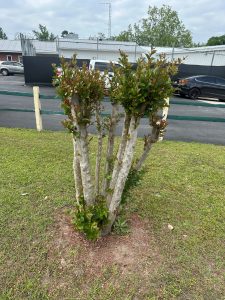Crape Myrtle is likely the most popular landscape tree in the South, for good reason. This species, comprised of varieties in all sorts of shapes, sizes, and colors, is tough as nails, thriving from the most manicured landscape to neglected parking lot islands. Though they’re easy to grow, beautiful, resilient little trees, they aren’t invincible and only as pretty as gardeners allow them to be. In fact, one of the best ways to ensure a poorly formed, bizarre-looking, disease-prone, short-lived crape myrtle is to commit Crape Murder.
Crape Murder is the twisted art of “pruning” specimens back into horrid shapes. Once shapely trees with well-developed crowns and attractive branching structure are reduced to a ghastly, sawed-off, fence post-like appearance. The large, generally jagged wounds that result from crape murder are slow to heal, if they ever do, and are a prime spot for insect and disease entry. Making matters worse, crape murder is rarely a one-time offense, rather practiced for years on end, never giving the tree a chance to heal, and leading to an early demise.

Previously beautiful ‘Muskogee’ Crape Myrtle murdered in spring 2025. Photo courtesy Daniel Leonard.
So, if the process is so obviously harmful to trees and an affront to evidence-based landscaping, why is it still so widely practiced? There are two primary reasons. First, large crape myrtle varieties like ‘Natchez’, ‘Muskogee’, and others are planted in areas without considering their mature size. These large growing cultivars can reach 30-40’ in height over time and outgrow many landscapes. To prevent this from happening, simply pay attention to the plant tag and consider the mature height of the cultivar. There are many great Crape Myrtle options, like ‘Acoma’, ‘Catawba’, the entire ‘Magic’ Series, and others, that top out at 15-20’ or shorter and many newer dwarf varieties that are smaller still. Second is the common belief that crape murder promotes a heavier bloom. This rationale at least contains some truth. Heavy pruning does tend to stimulate vegetative growth and subsequent flowering in plants – crape myrtle is no exception. However, though you may get larger blooms, they will be fewer than a properly grown crape would have, and the larger blooms often cause the whippy shoots they rest upon to sag and break, especially in wet and windy weather – the juice isn’t worth the squeeze.

Crape murder ruins the aesthetics of Crape Myrtle trees, creates a weak branching structure, and shortens the trees’ lifespans. Photo courtesy Daniel Leonard.
So, if you or someone you know have fallen victim to the above reasoning and dabbled in dendrological decapitation with your own crapes, it may comfort you to know that the damage can be undone over time. The simplest method of fixing crape murder damage is to simply stop doing it and let the tree grow as is. The tree will slowly heal itself but will always be misshapen, with a large, low trunk or two below the scene of the crime and dozens of limbs emerging from the same spot above. It isn’t ideal but I have seen some crapes rehabbed in this manner and they enjoyed a nice, long life. The better method is to wait until the next winter dormant season, break out a chainsaw (the suspected murder weapon), and cut the entire tree back to the ground. The following summer, allow the crape to flush out from the stump (there will be dozens of new shoots) and grow as much as possible. Then, the following winter when the recovering tree sheds its leaves, select 3-5 evenly spaced canes to leave and remove all the rest at the stump. Those 3-5 canes will form the primary branching structure of the rejuvenated tree. From there, you’ll only have to prune lightly each year to remove dead or crossing branching. Then, put up the chainsaw, enjoy your status as an enlightened gardener, and resolve to never prune your crape myrtles ever again.
For more information on Crape Myrtles or any other horticultural topic, contact your local UF/IFAS Extension office. Happy gardening!
- Mulch is a Must in Your Landscape - December 4, 2025
- Tis the Season – Why Winter is the Best Time to Plant Trees and Shrubs - November 26, 2025
- Feeling Blue (Ginger) This Fall - November 13, 2025
